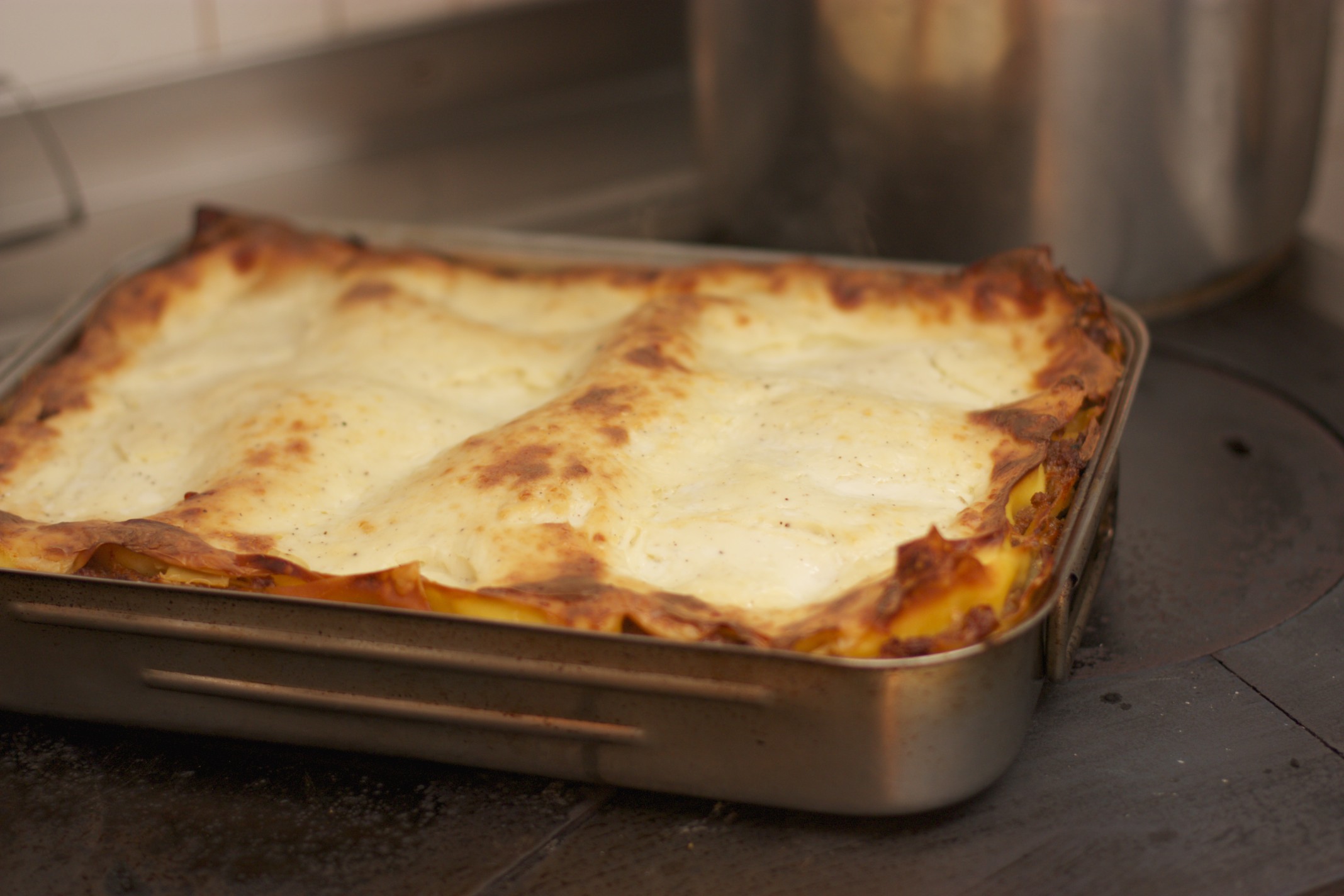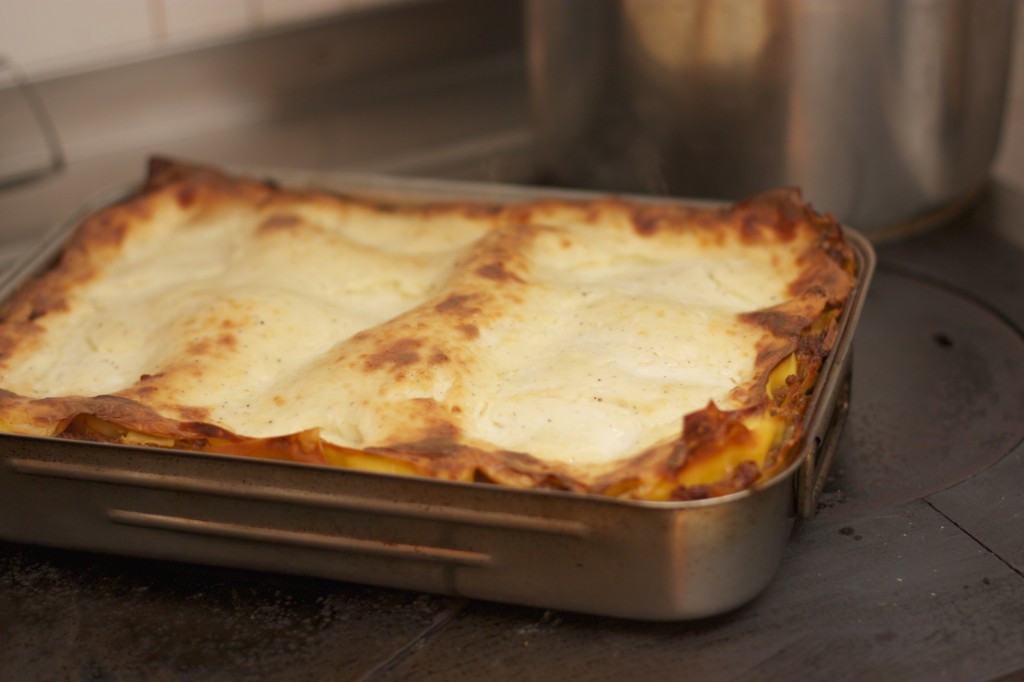This post is also available in: Italiano
In my teens, Sunday lunch always began with pasticcio (a type of northern Italian lasagna made with béchamel and ragù). The preparation of the pasticcio was learned with my aunt watched the cook who was hired to prepare baptism lunches, confirmations, weddings and other special events. The preparation of the pasta took all Saturday afternoon and was an opportunity to use up the bounty of eggs from the hens of our chicken coop. Everything was made on our farm: the flour from the millstone from the wheat of the fields, the milk for the béchamel sauce from the cows present in the barn, the minced meat resulting from the slaughter of some of the animals, the grated cheese made from mixed aged cheeses.
The men in the family appreciated this recipe as much as the guests who often attended the Sunday table. I normally collaborated in the preparation of the pasta and in mixing the béchamel. That meal preparation gave me the feeling of belonging to a solid family where one feels safe and where there is always something good to bring to the table. Over the years, as an adult I have experimented with various pasticcio recipes, with vegetables and with vegetable bechamel (made from broth and flour with no milk) which I prefer but, every now and then I like to go back to the traditional Sunday recipe, full-bodied and tasty, as way to pay homage to the history of the family and also so that new generations can have that experience. In today’s supermarket there are ready-made pasta dough sheets. A box of those can replace the handmade pasta recipe that I describe to you below.
Sunday Pasticcio
Course: Pasta, Recipes8
servings2
hours40
minutes2
hours40
minutesIngredients
- For the homemade lasagna
300 grams of flour (all purpose or half semola flour/ half 00 flour)
3 eggs
pinch of salt
- For the ragu meat sauce
700 grams (1.5 pounds) of lean ground beef
2 sweet italian sausages
2 carrots
1 yellow onion
2 celery sticks
1 small bunch of parsley
1 large can of whole peeled tomatoes
1 small glass of white wine
grated nutmeg
2 tablespoons of extra virgin olive oil
salt & pepper
- For the béchamel sauce
1 liter (1/4 gallon) of whole milk
6 tablespoons of flour
150 grams of butter (1 stick) + a little to butter your pan
140 grams of parmigiano reggiano
Directions
- For the Ragu (Meat Sauce)
- Dice the onion, celery, carrot, parsley. Pour two tablespoons of extra virgin olive oil into a large saucepan, add the chopped vegetables and the chopped sausages, the minced meat. Sauté quickly for about 10 minutes.
- Pour the white wine and let it evaporate for a few minutes. Add the peeled tomatoes, salt and pepper. Lower the heat over medium/low heat. Continue cooking slowly for about 1 hour and 30 minutes.
- For the Pasta
- Mix the flour with the eggs and a little salt, if it is too difficult to mix add a spoonful of milk. (Kitchen Aid works great if you have one). Otherwise, work the flour and eggs with your hands, often slapping the dough down on the kitchen counter; it must be very elastic. When ready, wrap it in a transparent sheet and let it rest for at least an hour.
- For the Béchamel Sauce
- Heat the milk in a saucepan and turn off as soon as it boils.
- In a saucepan with high sides pour the butter and melt it, when it is melted and boiling, add in the flour. With a wooden spoon or whisk, stir quickly and cook until the flour takes on a golden color.
- At this point slowly add the milk with a ladle, mixing thoroughly to prevent lumps from forming. When the milk has been completely absorbed, the bechamel is ready. The consistency must be creamy, neither too liquid nor too thick. Add a little salt and grated nutmeg.
- Pour half of the béchamel sauce into the sauce to make it creamy, keep half of it for the final covering.
- Pasta Cooking and Assembly
- Roll out the dough. Divide the ball into 4/5 pieces, flour each with a little flour and pass the dough on a pasta machine or roll it with a rolling pin, the dough must first be placed on the larger hole of the machine and then gradually on those thinner until an elastic and thin sheet is obtained.
- Divide it into rectangular sheets of the length of the pan that you have available for the pasticcio, I recommend a rectangular pan in steel or porcelain
- Boil salted water with a spoonful of olive oil and, when it boils, pour the sheets a few at a time and cook for 5 minutes.
- Place an old tablecloth on the table, with a perforated ladle remove the sheets from the boiling water and place them on the tablecloth.
- Butter the pan, put a first layer of pasta, pour a little ragù and a sprinkling of Parmesan. Repeat the operation until the pan is almost filled. It must end with a layer of pasta.
- At this point spread the remaining béchamel on the last layer so that it forms a kind of lid and sprinkle with the remaining Parmesan. Bake at 400 degrees. The pasticchio is cooked when a golden crust has formed after about 40 minutes. Serve hot cut into large squares.





